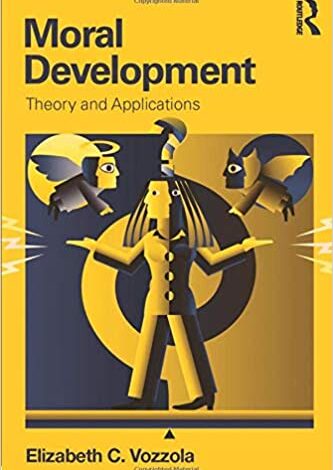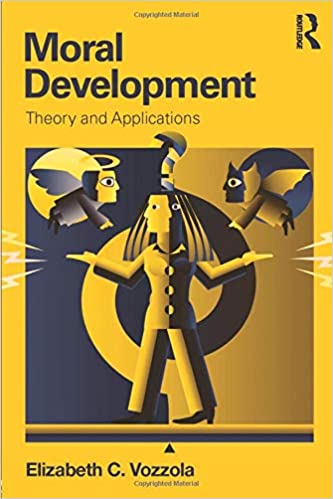دانلود کتاب Moral Development Theory and Applications

خرید ایبوک Moral Development Theory and Applications
برای دانلود ایبوک Moral Development Theory and Applications و خرید کتاب نظریه و کاربردهای رشد اخلاقی بر روی کلید خرید در انتهای صفحه کلیک کنید.پس از اتصال به درگاه پرداخت هزینه و تکمیل مراحل خرید ، لینک دانلود کتاب ایمیل می شود.این ایبوک در فرمت PDF اورجینال ارسال می شود.نسخه الکترونیکی کتاب قابلیت کپی برداری copy و Paste دارد.
در صورتی که نیاز به دانلود هر کتابی از آمازون یا گوگل بوک دارید، فقط کافیست ادرس اینترنتی کتاب را از سایت www.amazon.com و یا books.google.com برای ما ارسال کنید (راههای ارتباطی در صفحه تماس با گیگاپیپر ). پس از بررسی، هزینه ان اعلام می شود. پس از واریز نسخه الکترونیکی ارسال می شود.
ایبوک Moral Development Theory and Applications

Moral Development: Theory and Applications 1st Edition, Kindle Edition
by Elizabeth C. Vozzola (Author)
ISBN-10 : 0415821908
ISBN-13 : 978-0415821902
Download Please Contact Us :
Price : 10$
ادرس اینترنتی کتاب Moral Development Theory and Applications
https://www.worldcat.org/title/moral-development-theory-and-applications/oclc/872618395
https://www.taylorfrancis.com/books/9781315871226
دانلود رایگان کتاب Moral Development Theory and Applications
برای اطمینان از کیفیت ایبوک ، چند صفحه ابتدایی ان به صورت رایگان قرار داده شده است.
دانلود کتاب Moral Development Theory and Applications
This class-tested text provides a comprehensive overview of the classical and current theories of moral development and applications of these theories in various counseling and educational settings. Lively and accessible, this text engages students through numerous examples and boxes that highlight applications of moral development concepts in today’s media and/or interviews from some of today’s leading theorists or practitioners. Dilemma of the Day boxes help readers apply theory to real world situations. Each chapter concludes with discussion questions and further resources. Summary tables of theory strengths and weaknesses (Part 1) and tables that connect applications to their theoretical roots are provided in Part 2.
Other highlights include:
Provides an excellent resource for courses addressing the CACREP program objectives for Human Growth and Development.
Emphasis on application helps readers make the connection between theory and moral issues of our time.
Examines changes across time and experience in how people understand right and wrong and individual differences in moral judgments, emotions, and actions.
Demonstrates how theory is used by today‘s helping professionals (Part 1).
Integrates issues of gender and ethnicity throughout to prepare readers for practicing in a global culture.
Chapter on global perspectives (ch. 6) reviews theories on the cultural aspects of morality including examples from China, Islam, Latin America, and Africa.
Reviews the latest research methods techniques used in the field.
Integrates classic work with contemporary guidelines for assessment and treatment.
Highlights research on the moral and empathic development of antisocial youth, psychopaths, and individuals diagnosed on the Autism Spectrum.
each chapter in Part 1 provides a comprehensive overview of the theory under review, its strengths and challenges, and examples of how the theory applies to helping professionals. The theories covered include those by Freud, Piaget, Kohlberg, Rest, Gilligan, Nodding, Bandura, Turiel, Nucci, Haidt, and Shweder. Part 1 concludes with a summary of the key points and the strengths and weaknesses of each of the theories reviewed. Part 2 highlights promising applications of moral development theory in education and counseling. These include coverage of character education programs based on sound developmental theory and examples of how drawing on a deep grounding in moral development theory can help future counselors better evaluate their clients’ cognitive, emotional and behavioral challenges. The text explores specific approaches to helping clients with a variety of dysfunctional or developmental behavior problems like conduct disorder and psychopathy.
Ideal as a text for advanced undergraduate and/or graduate courses on moral development or moral psychology or as a supplement in courses on human and/or child and/or social and personality development taught in psychology, counseling, education, human development, family studies, social work, and religion, this book’s applied approach also appeals to mental health and school counselors.
دانلود ایبوک نظریه و کاربردهای رشد اخلاقی
این متن تست شده كلاس ، مروری جامع بر نظریه های كلاسیك و فعلی رشد اخلاقی و كاربردهای این نظریه ها در زمینه های مختلف مشاوره و آموزشی را ارائه می دهد. این متن پر جنب و جوش و در دسترس ، دانشجویان را از طریق مثالها و جعبه های مختلفی که کاربردهای مفاهیم رشد اخلاقی را در رسانه های امروزی و / یا مصاحبه های برخی از نظریه پردازان یا پزشکان برجسته امروز برجسته می کند ، درگیر خود می کند. جعبه های معضل روز به خوانندگان کمک می کند تا نظریه را در موقعیت های دنیای واقعی اعمال کنند. هر فصل با سوالات بحث و منابع بیشتر به پایان می رسد. جداول خلاصه نقاط قوت و ضعف نظریه (قسمت 1) و جداول اتصال برنامه ها به ریشه های نظری آنها در قسمت 2 ارائه شده است.
سایر موارد برجسته عبارتند از:
یک منبع عالی برای دوره های پرداختن به اهداف برنامه CACREP برای رشد و توسعه انسانی فراهم می کند.
تأکید بر کاربرد به خوانندگان کمک می کند تا بین تئوری و مسائل اخلاقی زمان ما ارتباط برقرار کنند.
تغییرات در طول زمان و تجربه را در نحوه درک مردم از تفاوتهای درست و غلط و فردی در قضاوتها ، احساسات و اعمال اخلاقی بررسی می کند.
نشان می دهد که چگونه تئوری توسط متخصصان امروزی کمک می کند (قسمت 1).
مسائل جنسیت و قومیت را در یک جا ادغام می کند تا خوانندگان را برای تمرین در یک فرهنگ جهانی آماده کند.
فصل چشم اندازهای جهانی (فصل 6) نظریه های مربوط به جنبه های فرهنگی اخلاق از جمله نمونه هایی از چین ، اسلام ، آمریکای لاتین و آفریقا را مرور می کند.
آخرین تکنیک های روش تحقیق مورد استفاده در این زمینه را مرور می کند.
کار کلاسیک را با رهنمودهای معاصر ارزیابی و درمان ادغام می کند.
تحقیقات برجسته درباره رشد اخلاقی و همدلی جوانان ضد اجتماعی ، روان پریش ها و افراد مبتلا به طیف اوتیسم را برجسته می کند.
هر فصل در بخش 1 مروری جامع بر نظریه مورد بررسی ، نقاط قوت و چالش های آن و نمونه هایی از نحوه کاربرد این تئوری در کمک به متخصصان را ارائه می دهد. نظریه های مطرح شده شامل نظریه های فروید ، پیاژه ، کوهلبرگ ، رست ، گیلیگان ، نودینگ ، بندورا ، توریل ، نوچی ، هاید و شودر است. قسمت 1 با خلاصه ای از نکات کلیدی و نقاط قوت و ضعف هر یک از نظریه های بررسی شده به پایان می رسد. بخش 2 برنامه های امیدوار کننده تئوری رشد اخلاقی را در آموزش و مشاوره برجسته می کند. این موارد شامل پوشش برنامه های آموزش شخصیت مبتنی بر نظریه رشد صحیح و مثالهایی از چگونگی استفاده از یک زمینه عمیق در نظریه رشد اخلاقی می تواند به مشاوران آینده کمک کند تا چالشهای شناختی ، عاطفی و رفتاری مشتریان خود را بهتر ارزیابی کنند. این متن رویکردهای ویژه ای را برای کمک به مشتریانی که دارای انواع مشکلات رفتاری ناکارآمد یا رشد مانند اختلال سلوک و روان پریشی هستند ، بررسی می کند.
ایده آل به عنوان متنی برای دوره های کارشناسی ارشد و / یا کارشناسی ارشد در زمینه رشد اخلاقی یا روانشناسی اخلاقی یا به عنوان مکمل در دوره های انسانی و / یا کودک و / یا رشد اجتماعی و شخصیتی تدریس شده در روانشناسی ، مشاوره ، آموزش ، رشد انسانی ، مطالعات خانوادگی ، مددکاری اجتماعی و مذهب ، رویکرد کاربردی این کتاب همچنین مورد توجه مشاوران بهداشت روان و مدارس است.
فهرست مطالب Moral Development Theory and Applications
Cover; Title; Copyright; Dedication; Contents; Figures and Tables; About the Author; Preface; Acknowledgments; PART I Moral Development in the 21st Century: Theoretical Roots and New Directions; 1 Introduction; 2 Classic Theories of Morality: Freud and Piaget; 3 From Stages to Schemas: Kohlberg and Rest; 4 Theoretical Challenges to Classic Cognitive Developmental Models; 5 The Rise of Theories from Neuroscience and Evolutionary Perspectives; 6 Global Perspectives: A Sampling of Research and Issues; 7 Conclusion: In a Different Mind; PART II Applications of Theory to Practice. 8 Applied Moral Education: Accomplishments and New Directions9 Developmental Therapy: Helping Clients Grapple with Core Moral Issues; 10 When Development Goes Awry: Deficits in Moral and Empathic Development; 11 Conclusion: How to Live and What to Do?; References; Author Index; Subject Index.